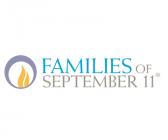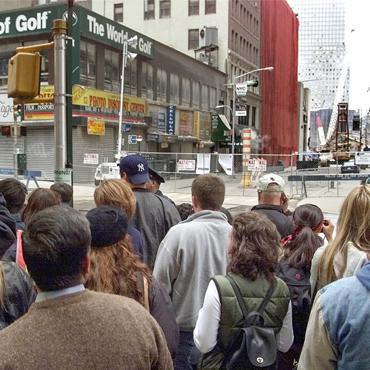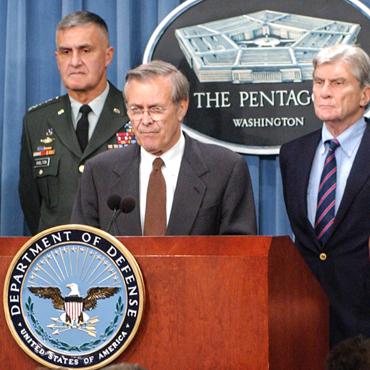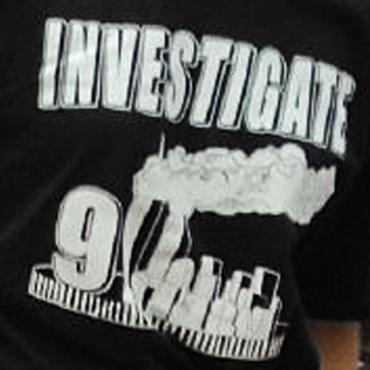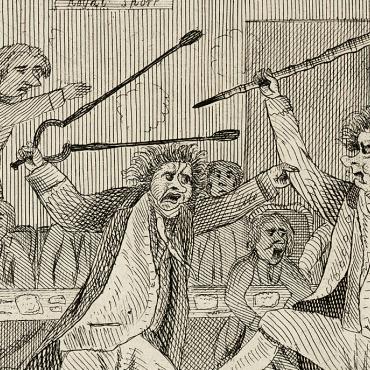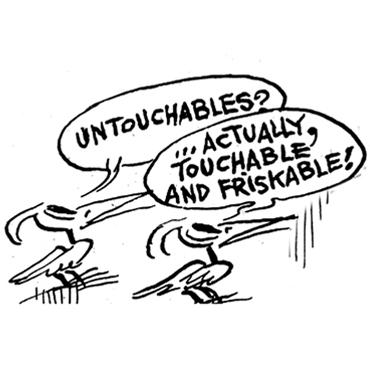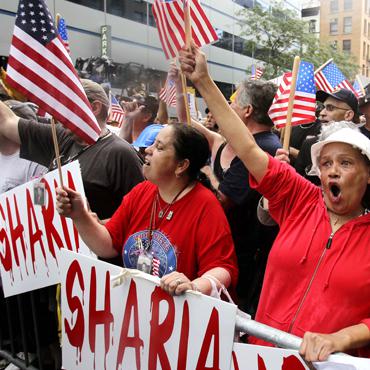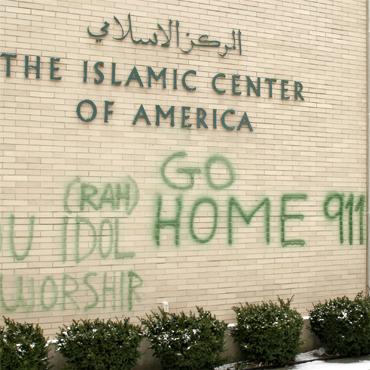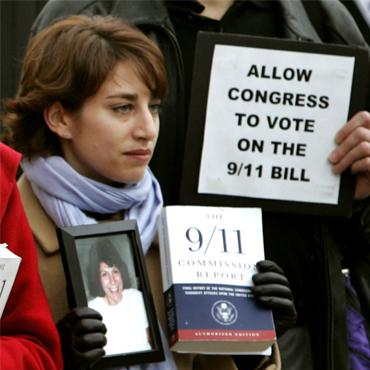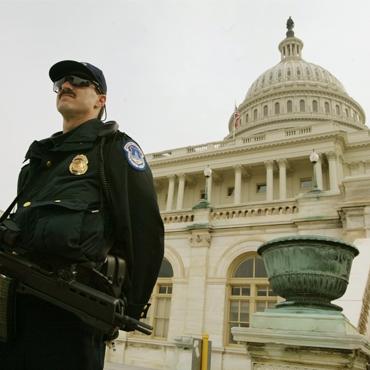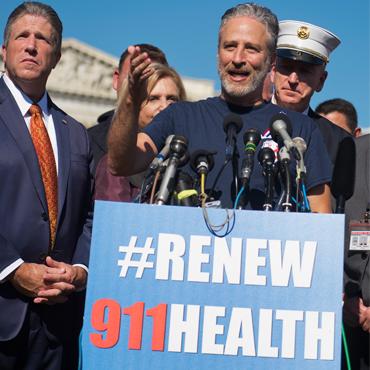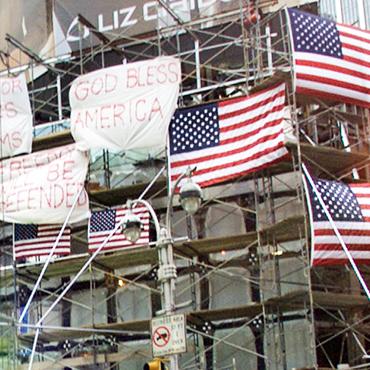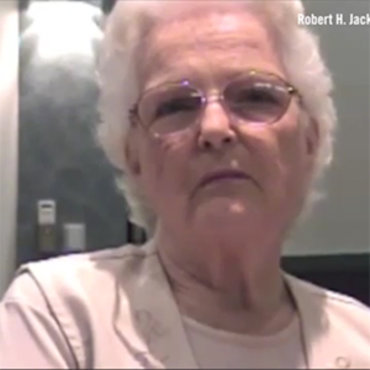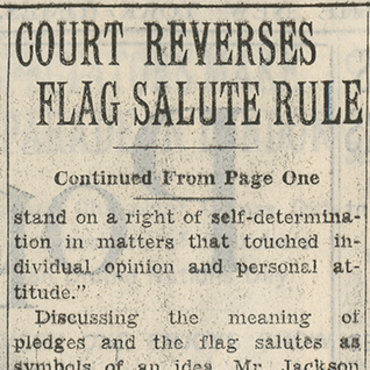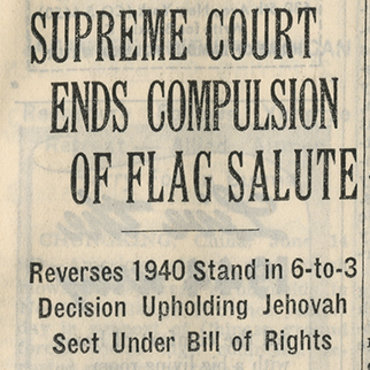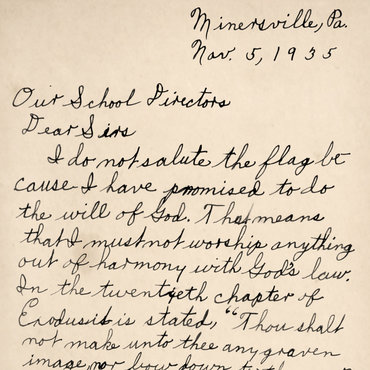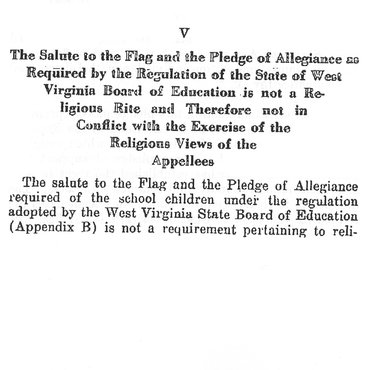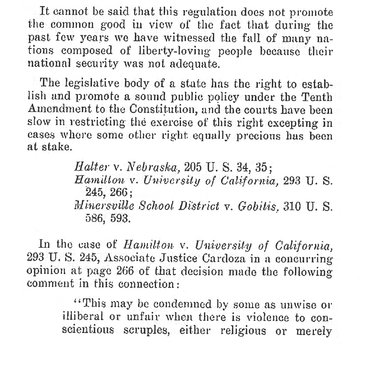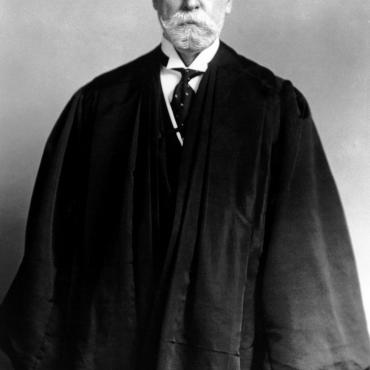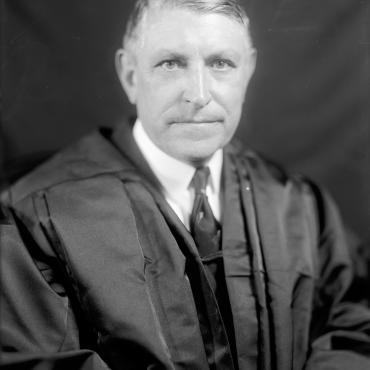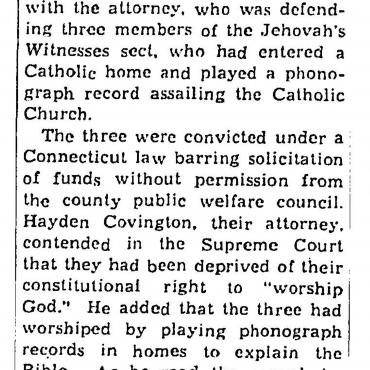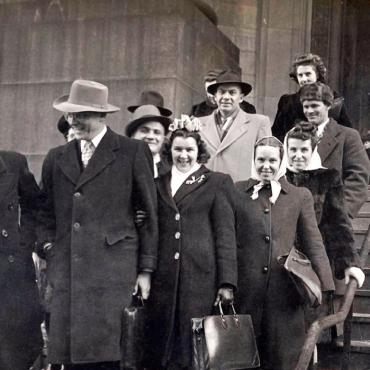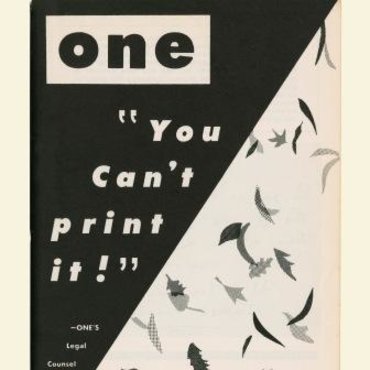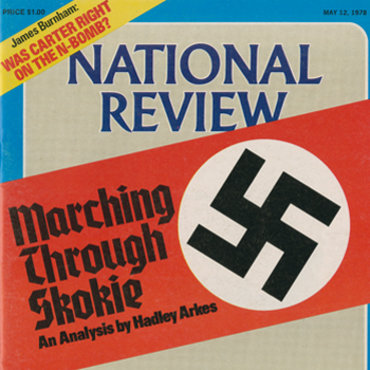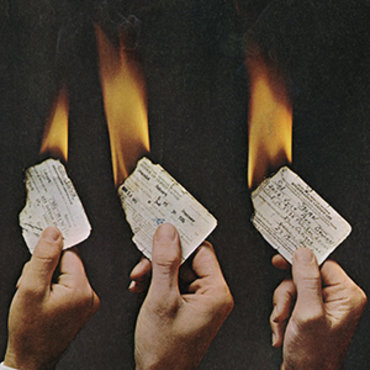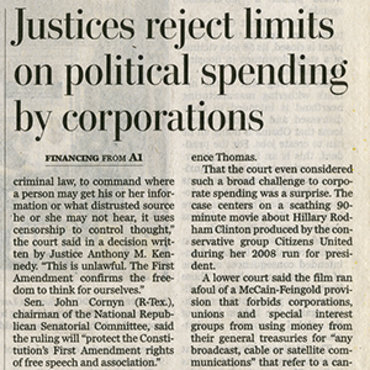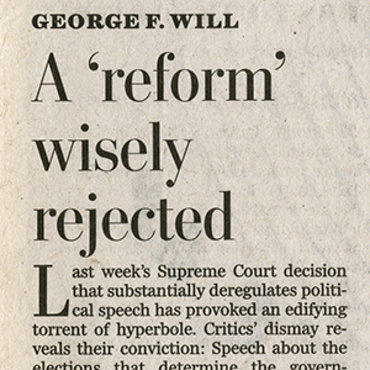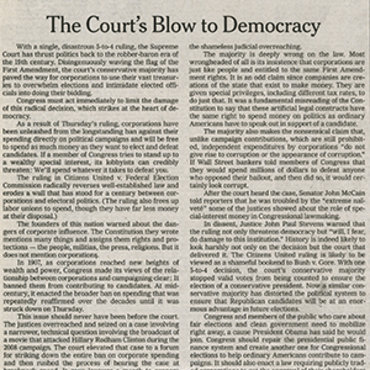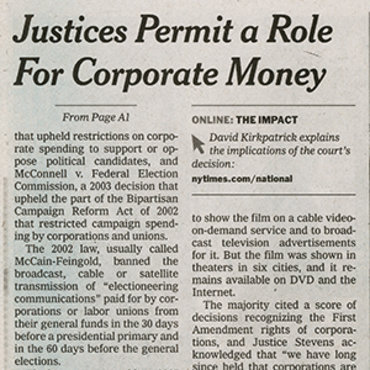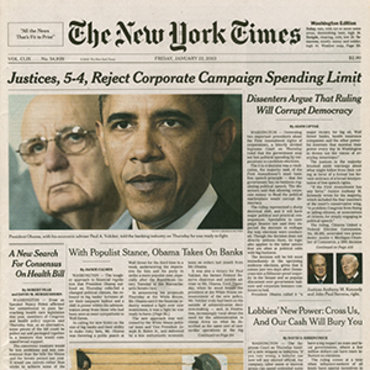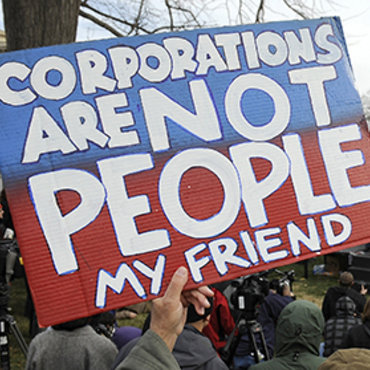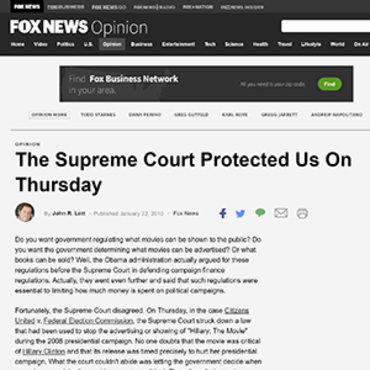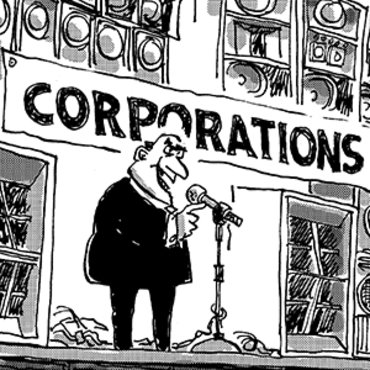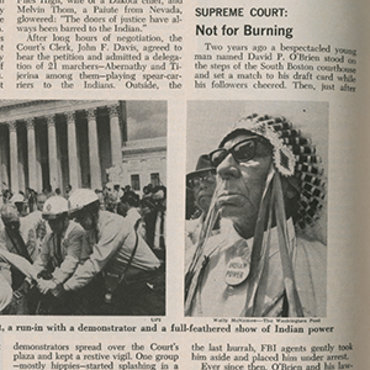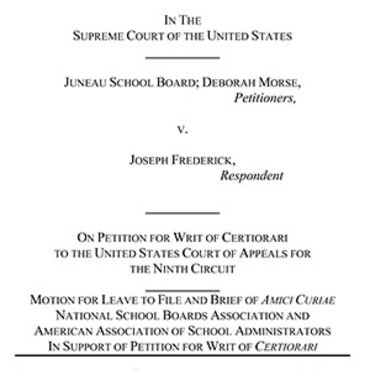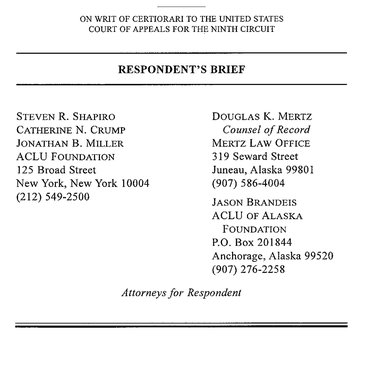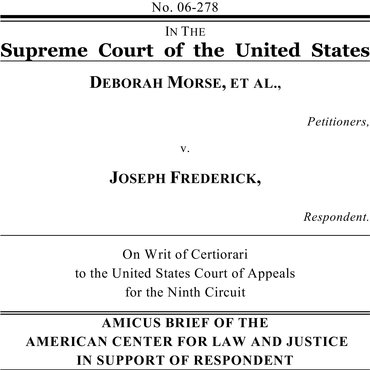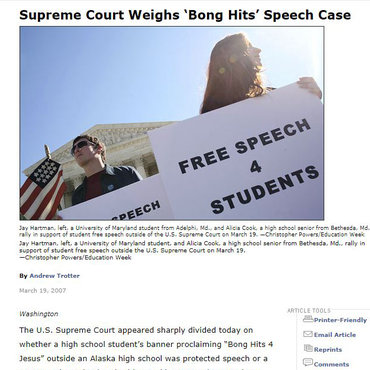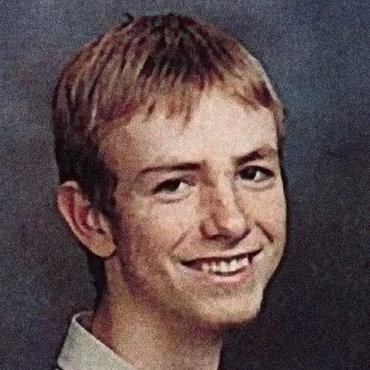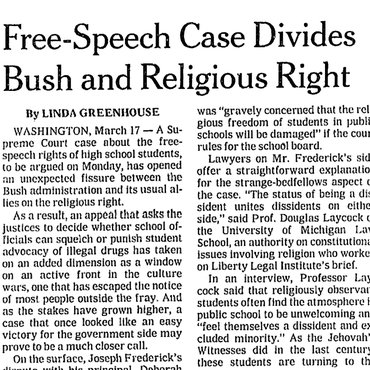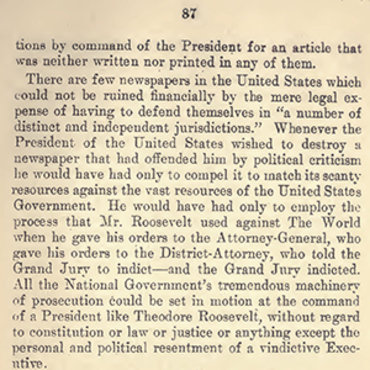1938: Spreading One Religion, Attacking Another
Can Jehovah's Witnesses offend Catholic listeners while out in public seeking new followers?
Get even more great free content!
This content contains copyrighted material that requires a free NewseumED account.
Registration is fast, easy, and comes with 100% free access to our vast collection of videos, artifacts, interactive content, and more.
NewseumED is provided as a free educational resource and contains copyrighted material. Registration is required for full access. Signing up is simple and free.
With a free NewseumED account, you can:
- Watch timely and informative videos
- Access expertly crafted lesson plans
- Download an array of classroom resources
- and much more!
This Critical Debate is part of a Debate Comparison:
See all Debate Comparisons- Constitution
- Religious Liberty
- Supreme Court
- 9-12
- College/University
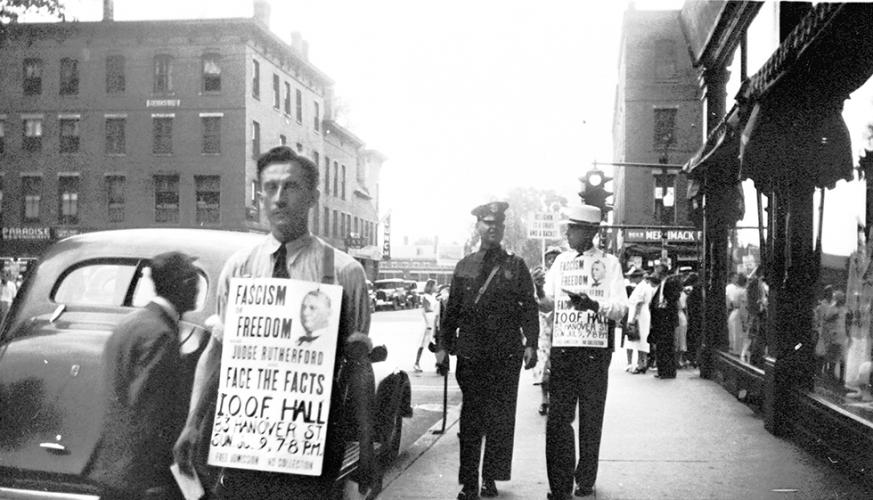
The Witnesses' signs show a portrait of their leader Joseph "Judge" Rutherford, who made many of the recordings played by Witnesses during their proselytizing.
- Pass out and read the Spreading One Religion case study scenario. Check for comprehension and ask students to identify the First Amendment freedom(s) at issue in this case.
- Break your class into small groups and assign each group one of the people/perspectives. Hand out copies of the Organizing Evidence and Present Your Position worksheets. Give groups 30 minutes to look at the primary sources online and answer the worksheet questions.
- Have each group present their position and arguments. Keep the gallery of case study resources on NewseumED.org open so students can refer to them as they explain their reasoning.
- Historical case study handout, one per student (download)
- Organizing Evidence and Present Your Position worksheets, one of each per group (download)
- Case study primary sources (below)
- NewseumED Cantwell v. Conn. Related Resources Pinterest Board (optional)
Can a religious group proselytize and criticize another religion when seeking new followers?
On a Sunday in April in 1938, Jehovah’s Witnesses Newton Cantwell and his sons, Jesse and Russell, travel to a largely Catholic neighborhood in New Haven, Conn. They bring pamphlets, books and portable record players to spread the word about their religion.
A group of men on the street agree to listen to one of the records. In the recording, the leader of the Jehovah’s Witnesses harshly criticizes Roman Catholicism. He calls the Catholic Church an “instrument of Satan” and says that it “robs the people of their money and destroys their peace of mind and freedom of action.” The listeners, who are Catholic, are offended. They tell the Cantwells to go away, and they later testify that they might have punched the Cantwells if the police had not arrived.
The Cantwells are arrested and charged with violating a local law that requires a permit to solicit for religious causes and with causing a breach of the peace by offending their listeners and provoking an angry response. This street-corner confrontation sparks a lawsuit that rises all the way to the Supreme Court.
Take the role of a historical figure below and find evidence to argue your case.
-
 ?Hayden Covington was the main legal counsel for the Jehovah's Witnesses from 1939 to 1963. The first major case he worked on was Minersville School District v. Gobitis.Watch Tower Bible and Tract Society of Pennsylvania
?Hayden Covington was the main legal counsel for the Jehovah's Witnesses from 1939 to 1963. The first major case he worked on was Minersville School District v. Gobitis.Watch Tower Bible and Tract Society of PennsylvaniaHayden Covington, lawyer representing the Cantwells
The First Amendment allows the Cantwells to share all of their beliefs, including their distrust of Roman Catholicism. Those who are not interested do not have to stop and listen, and they can walk away at any time.
-
Men listening to the Cantwell record
Jehovah’s Witnesses such as the Cantwells should not be allowed to broadcast a message that accuses another religion of being evil. The message is insulting and should never have been brought into our neighborhood. They are lucky we didn’t respond violently to their attack on our faith.
-
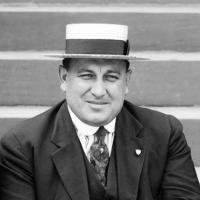 ?This photograph shows Francis A. Pallotti in 1918.Courtesy Connecticut Digital Archives Collection
?This photograph shows Francis A. Pallotti in 1918.Courtesy Connecticut Digital Archives CollectionFrancis Pallotti, lawyer representing the state of Connecticut
The controversial messages that the Cantwells shared on the streets of New Haven have the potential to cause conflicts between our citizens, possibly even sparking violent confrontations. It is our duty as a state to keep the peace, and therefore we must regulate the types of messages being shared on our streets.
"No person shall solicit money, services, subscriptions or any valuable thing for any alleged religious, charitable or philanthropic cause … unless such cause shall have been approved by the secretary of the public welfare council."
-
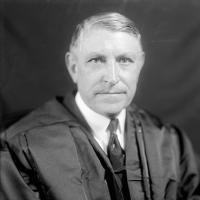 ?Justice Owen Roberts served on the Supreme Court from 1930 to 1945.
?Justice Owen Roberts served on the Supreme Court from 1930 to 1945.Supreme Court Justice Owen Roberts
Although the Cantwells’s message was offensive to some individuals, it did not cause any actual harm, and these types of conflicts of beliefs will always arise in our diverse nation. States as well as the federal government have a duty to uphold the First Amendment by limiting their regulation of religious freedom to the bare minimum.
"The people of this nation have ordained ... that, in spite of the probability of excesses and abuses, these liberties are, in the long view, essential to enlightened opinion and right conduct on the part of the citizens of a democracy.”
- People disagree on many issues. Should groups be prohibited from publicly sharing information others dislike?
- Did the Cantwells harm those hearing their message? Did they harm Roman Catholicism? Can speech cause harm?
- Were the Catholic residents forced to listen to the Cantwells's message?
- What does it mean to disturb the peace? Can sharing your beliefs, if offensive to some, disturb the peace?
- How are beliefs different than actions? Can one’s actions prevent them from publicly sharing their beliefs?
-
Common Core State Standards: CCSS.ELA-LITERACY.CCRA.SL.1
Prepare for and participate effectively in a range of conversations and collaborations with diverse partners, building on others' ideas and expressing their own clearly and persuasively.
-
NCSS C3 Framework: D4.1.6-8 and D4.1.9-12
6 - 8: Construct arguments using claims and evidence from multiple sources, while acknowledging the strengths and limitations of the arguments. 9 - 12: Construct arguments using precise and knowledgeable claims, with evidence from multiple sources, while acknowledging counterclaims and evidentiary weaknesses.
-
Center for Civic Education: CCE.II
A. What is the American idea of constitutional government? B. What are the distinctive characteristics of American society? C. What is American political culture? D. What values and principles are basic to American constitutional democracy?
